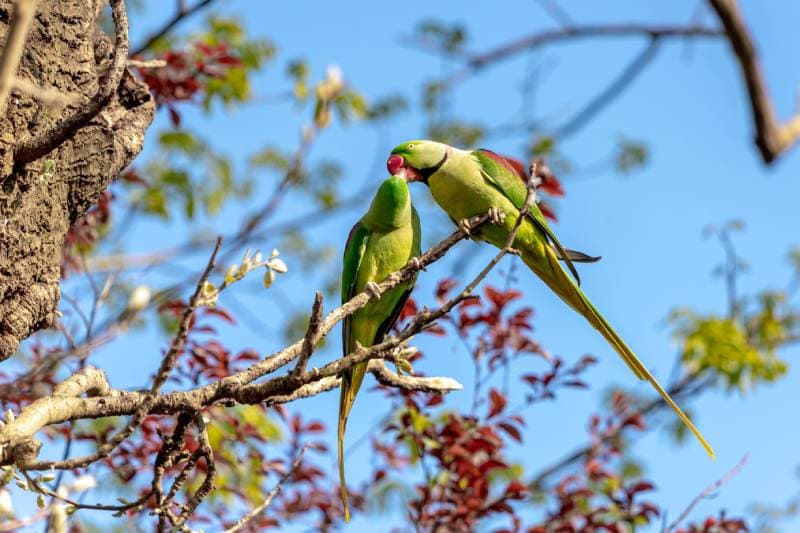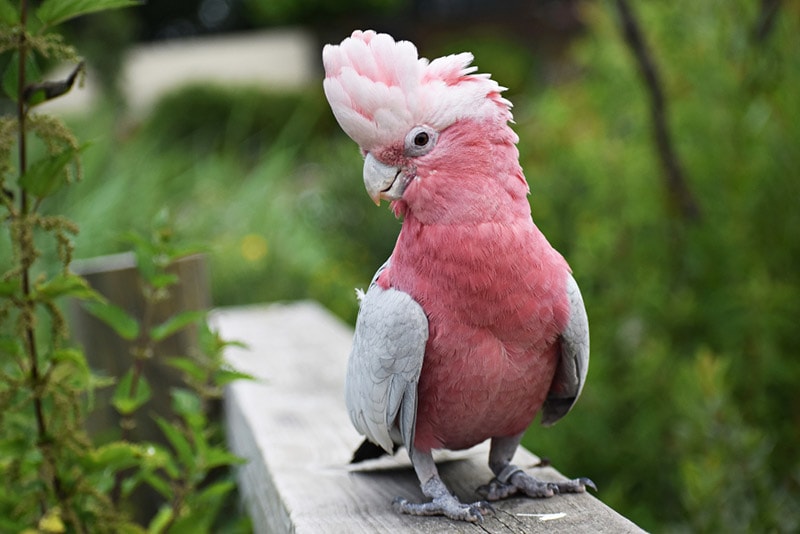Why Do Parakeets Kiss Each Other? Vet-Approved Bird Behavior Explanation
Updated on

Click to Skip Ahead
Parakeets are some of the most adorable and affectionate avian pets you can own, and they’re famous for kissing each other, like lovebirds. While parakeet kisses aren’t exactly like our wet, mushy lip locks, they still kiss to show affection and bond with their mates. Other times, you’re just not looking closely enough and they’re simply grooming or preening each other. In that way, many people think that parakeet kisses really are very similar to romantic human smooches! That said, parakeet kisses are usually a sign of courtship and are an attempt at feeding their mate (known as allofeeding).
If you’ve ever wondered about how parakeets show affection or if there’s a difference between parakeet kisses and preening, you’re in the right place. Let’s check out a bit about both of those topics, as well as how you can encourage your parakeets to bond and show affection.
Species Disclaimer: The term “parakeet” isn’t a taxonomical reference to any genus or family of parrots. Instead, the word itself is a term given to several small to medium-sized species of parrots with long tail feathers. In this article, we’ll be specifically focusing on the ring-necked parakeet (Psittacula krameri). However, this information is also transferable to many other species of parrots that are sometimes referred to as parakeets.
Signs of Parakeet Affection
You probably already know that your parakeets love or at least like each other if they’re kissing, but that’s far from the only sign that your birds are bonding. Parakeets show their affection in several other ways besides superficial face pecks.
- Spending time together: Bonded parakeets appear inseparable, preferring to perch, sleep, and spend time together when possible.
- Preening: Preening is a healthy grooming activity that allows your parrots to water-proof and organize their feathers, dislodge feather dander and damaged feathers, and it keeps their feathers in showy shape. Bonded parakeets may scratch and preen each other’s heads.
- “Kissing”: What we perceive as “kissing” is in fact an attempt at allofeeding, where one parakeet (often the male) tries to pass food from his crop to his mate. This indicates his ability to provide for her and is an important part of their courtship. Female parrots may also partake in this “kissing” ritual. This form of allofeeding is also how they feed their hatchlings.
Are My Parakeets Kissing or Fighting? How to Tell

For someone new to pet birds, kissing and fighting look a lot alike in our bird’s cage, and it’s not always apparent how to tell aggression from affection.
Generally speaking, parakeets have a strong flock drive and readily get along with each other when housed together. They enjoy the companionship other parakeets offer them. However, squabbles can break out, especially when there are multiple parakeets keen on mating but limited nest boxes in their aviary or enclosure.
Find out the difference by looking for some common signs of parakeet aggression just below.
- Aggressive posture: Dominant parakeets may fluff up their feathers, pin their iris, and lunge at another parakeet to assert dominance.
- Chasing: If one parakeet is persistently chasing the other and biting them, their “kisses” are more harassment than affection.
- Squawking and screaming: Unusually loud screams or squawks when your birds interact may be a sign that one bird is uncomfortable with the situation.
- Resource guarding: Parakeets usually don’t fight over resources, but a bonded pair may turn aggressive if food, water, or nesting boxes are limited in their enclosure.
- Perching Levels: Within a flock, the more dominant members prefer to perch higher up on a tree or branches. You may be able to pick up signs of aggression if you notice one parakeet persistently preventing another one from accessing a higher perch.
Parakeet Kisses vs. Preening: What’s the Difference?
It can be hard to tell at a glance whether your birds are kissing to show love or simply to preen or groom each other. Like all birds and many other animals, parakeets will groom family members, friends, or mates to show each other love. Communal preening helps your birds remove dirt and damaged feathers and spread oils from the preening glands through the feathers.
“Kissing,” on the other hand, involves the contact of their beaks. At times, a pet parakeet may attempt to “kiss” you as well. This is because, as pets, they often view you as a member of their flock.
How Can I Get My Parakeets to Bond?

Parakeets can be finicky critters and don’t always get along when they first meet, particularly if they’re introduced suddenly, live in cramped quarters, or live with other birds in the cage. For the best results, you should take things slow when trying to get your birds to bond when they’re not yet bonded.
- Buy two cages: Before moving them in together, put each bird in their own cage and move the two side by side so they can meet from a safe, comfortable distance.
- Don’t neglect your first bird: Your first parakeet may initially be jealous when you bring home a new bird. Keep giving them the regular amount of attention and love you always have to prevent jealousy-induced aggression toward the other parakeet.
- Let your original parakeet investigate: Bring your original parakeet out of their cage (assuming they are tame), and let them investigate the newcomer.
- Supervised together time: After a week or two of separated cages, put your birds in a third neutral meeting cage with ample food and water and carefully observe them. If they become aggressive in any way, remove them and try again another day.
- Day visits, then sleepovers: If their first meeting goes well, you can let your parakeets hang out together in the same cage for a whole day, and then, later and once you trust them, see how they do with an overnight sleepover in the same cage.
Please take note that, like many other parrots, ring-necked parakeets form long-lasting bonds and are considered mostly monogamous. An individual that has formed a bond with another parakeet will not pair-bond with another parakeet in most circumstances. Therefore, you shouldn’t adopt a parakeet that has already pair-bonded with another bird, as they may be in a constant state of separation stress and will likely not bond with your bird. In such circumstances, the best thing to do is to adopt both of them (assuming you have enough resources to care for both birds).
Conclusion
Parakeets are gorgeous, delicate companion birds that love to kiss as part of a courtship display. Generally speaking, aggression is accompanied with other signs, although in most cases, these birds quickly learn to coexist and have a very strong desire to stay in a flock. Nonetheless, to help your birds get along, don’t rush their introduction, and always keep a second cage handy in case their squabbles start to get overly physical.
Featured Image Credit: Wut-Mopppie, Shutterstock












